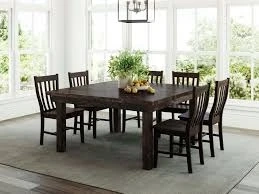Wooden dining tables are a timeless addition to any home, often acting as the central hub for family meals, celebrations, and everyday moments. Their natural beauty, warmth, and durability make them a favorite for homeowners across the United States. However, if you have young children or energetic pets, protecting your wooden dining table becomes more than just an afterthought—it’s a necessity. Between food spills, coloring sessions, claw marks, and general rough use, your beautiful table can quickly start to show signs of wear without the right precautions in place. If you’ve ever wondered how to keep your investment in pristine shape while still enjoying everyday family life, you’re not alone. Many buyers also want to understand the Wood Dining Table price in United States when considering quality and durability.
The Importance of Choosing the Right Wood Type
Not all wood species are created equal when it comes to withstanding daily abuse. Hardwoods like oak, maple, and walnut tend to fare better against scratches and dents than softer woods such as pine or fir. If your dining table will be in constant use by kids or pets, opting for a hardwood surface could mean years of added longevity. Hardwoods are more resistant to impressions from toy cars or dog paws and generally hold up better against moisture and stains.
Applying a Durable Finish
A strong, protective finish is your wooden dining table’s first line of defense. Options like polyurethane, lacquer, and conversion varnish form a hard shell over the wood, shielding it from spills, crayons, food stains, and pet-related accidents. You might also consider an oil-based finish, which penetrates deeper into the wood grain. While this type of finish gives the table a natural look and is easier to touch up, it may require more frequent reapplications. A matte or satin finish can help hide imperfections better than high-gloss options, which tend to highlight every scratch and smudge.
Use Table Pads and Protective Covers
For families with small children or pets, investing in high-quality table pads or covers is a simple but highly effective measure. These padded covers protect the table from spills, burns, and impact damage. You can also add waterproof placemats or a clear plastic cover over a decorative tablecloth for an added layer of protection. Don’t underestimate the value of a soft table runner—these can guard against direct contact with pet claws and tiny hands that like to bang on the table’s surface.
Encourage Table Manners Early
While it may seem obvious, one of the most effective ways to protect your dining table is to teach kids from a young age how to treat it with care. No climbing, banging, or using it as a drawing surface. Reinforcing these habits early on can drastically reduce the chances of accidental damage. For pets, use behavioral training to discourage jumping onto the table or chewing on its legs.
Keep Pet Accessories Away
If you have pets that eat or drink indoors, avoid placing their bowls near the dining table. Spilled water and food can easily find their way to the table legs, causing swelling, warping, or staining over time. Instead, designate a separate feeding station in the kitchen or a mudroom. If your pets shed heavily, be mindful about brushing them away from the dining area to reduce the amount of fur that may collect on or around the table.
Regular Cleaning and Maintenance
A regular cleaning routine is key to maintaining the luster and integrity of your wooden table. Always use a soft, damp cloth to clean the surface, followed by a dry cloth to remove any excess moisture. Avoid harsh chemical cleaners, which can strip the finish or discolor the wood. Instead, opt for natural wood-safe products or a mix of mild soap and water. Every few months, condition your table with a quality furniture polish or oil to maintain its finish and keep the wood from drying out.
Repairing Minor Damage
Despite all precautions, minor dings and scratches are inevitable. Fortunately, many small imperfections can be fixed with a little effort. Wood repair markers and wax filler sticks are great for touching up light scratches. For deeper dents, consider using a wood filler or even professional refinishing if needed. Addressing these issues early prevents them from becoming more visible and harder to repair later.
Creating a Kid and Pet-Friendly Dining Environment
Consider designing the entire dining space to complement your efforts to protect the table. Use washable seat cushions or slipcovers that are easy to remove and clean. Choose rugs that can be easily cleaned or are resistant to stains. You might also want to select chairs with fewer nooks and crannies where crumbs or pet fur can accumulate. These design choices work together to reduce wear and tear on your wooden dining table and keep the entire space looking fresh.
Set Boundaries and Use Furniture Strategically
Placing furniture strategically can help keep pets and toddlers away from the table when needed. Baby gates, playpens, or even rearranging furniture to create a boundary can help redirect traffic away from the dining area. You can also install small bumpers or corner protectors on the table to prevent injuries and protect the edges from damage.
Long-Term Planning: Think About Growth
If your family is still growing, consider choosing a dining table that will evolve with your needs. An extendable table or one with replaceable parts can be a smart investment. Additionally, opting for a timeless, neutral finish allows you to refinish or restain it in the future to adapt to changes in home decor or lifestyle.
When you're ready to invest in a dining table that combines beauty, durability, and value, understanding Wood Dining Table prices in United States helps guide your purchasing decision wisely.
Frequently Asked Questions (FAQs)
Q: Can I use glass to protect my wood dining table?
A: Yes, a custom glass top can offer excellent protection without hiding the beauty of the wood. It’s especially useful for protecting against spills, crayons, and pet claws.
Q: How often should I polish my wooden dining table?
A: Depending on the finish and frequency of use, polishing every 2–3 months is usually sufficient. If your table has a wax or oil finish, you might need to apply product more often.
Q: What should I do if my pet scratches the table?
A: Minor surface scratches can often be covered using a wood repair marker or filled with wax filler sticks. For deeper scratches, sanding and refinishing might be required.
Q: Are tablecloths enough to protect the wood surface?
A: While tablecloths offer basic protection against dust and light scratches, adding a table pad or clear plastic cover provides better spill resistance and cushioning against impact.
Q: What’s the best type of wood for families with kids?
A: Hardwoods like oak, maple, and walnut are more resistant to dents and scratches and are ideal for families with active children or pets.
Conclusion
Protecting your wooden dining table from the wear and tear of everyday life with kids and pets doesn’t mean you have to sacrifice style or functionality. With smart choices in wood types, protective finishes, regular maintenance, and a few simple habits, you can enjoy your beautiful table for years to come. Whether you’re shopping for your first family dining table or looking to upgrade your current setup, Five star furniture store is one of the best places for the lowest Wood Dining Table prices in United States. With a commitment to quality, durability, and style, they make it easy to find a table that fits both your budget and your busy family life.


